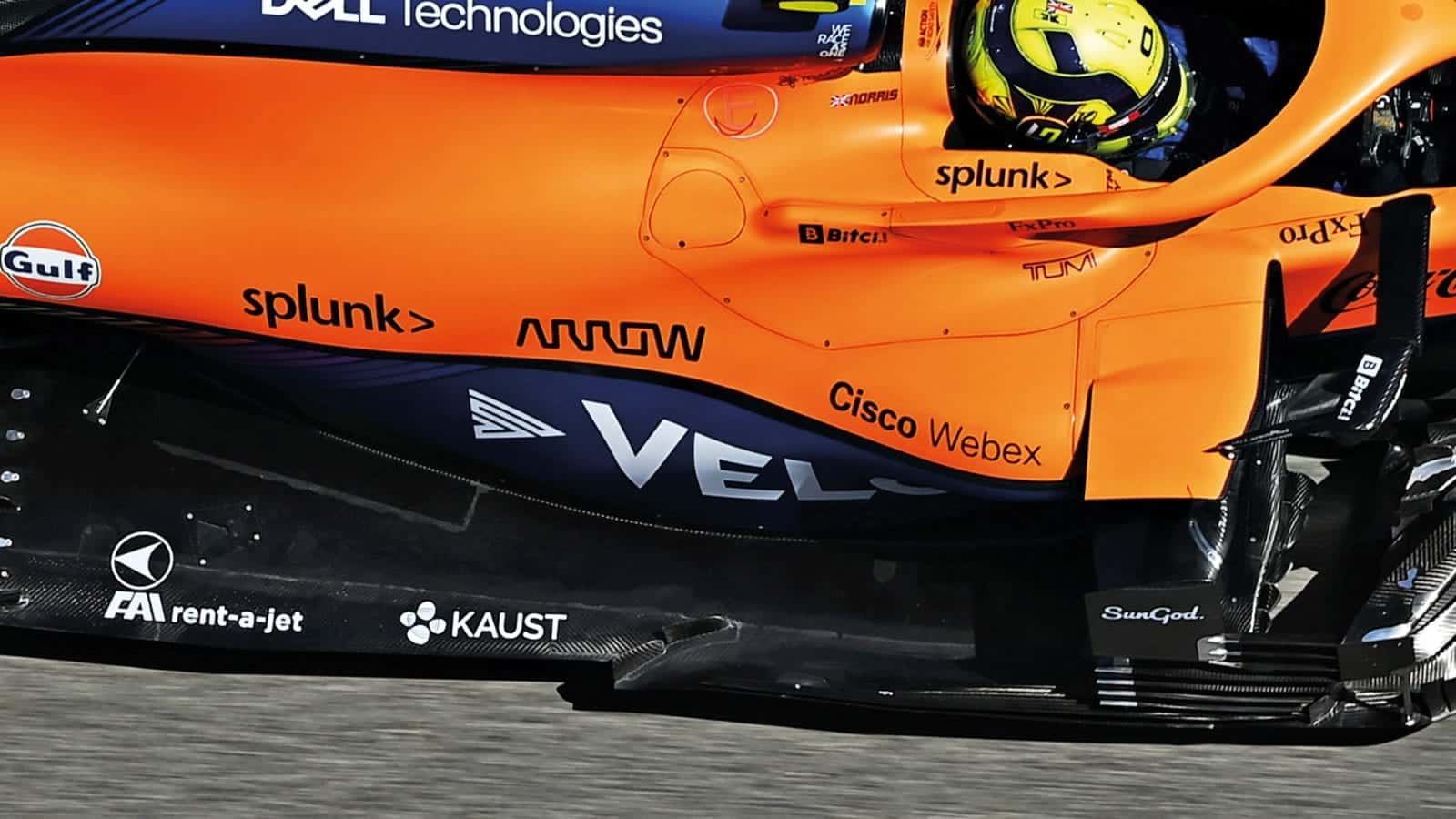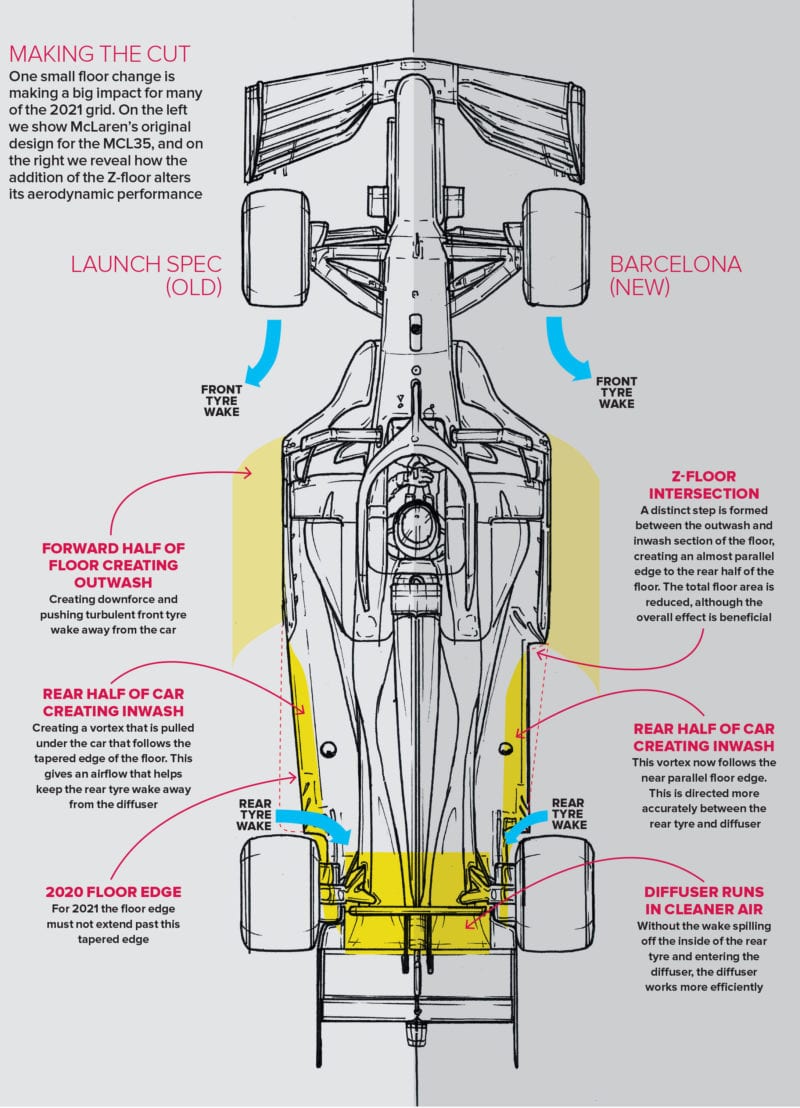McLaren’s Z-floor: analysing the latest 2021 F1 upgrade
It may look like the work of Zorro, but there’s some clever thinking behind this tweak, says Mark Hughes

The new ‘Z’ shape helps to send more air around the floor edges, sealing it and creating vital downforce
Clive Mason/F1 via Getty Images
McLaren had a significant upgrade fitted to its car in Barcelona, featuring a new floor and subtly different front wing. The outer end of the wing’s mainplane has been raised slightly, giving a greater ‘throat’ area beneath, while the gap between the mainplane and the first flap has been widened. Both these changes suggest McLaren is seeking to make the car less pitch-sensitive. With the previous smaller throat area, the gap between the wing’s underside and the ground at that outboard end would be very small as the car dives under braking, enough to generate significant ground effect. As the surface gets closer to the ground the downforce increases exponentially. If this ramp-up on downforce is too sudden it can make the car nervous and induce rear instability.
This is generally a more likely problem to encounter with the 2021 generation of cars because of the reduced rear downforce from the trimmed floor and other aero restrictions at the rear around the diffuser and brake ducts. One of the rebalancing processes that teams are going through is to make the front downforce less aggressive as the car dives, simply because the rear can no longer withstand such sudden increases in load.
Ideally, they would wish to retain the extra front downforce by boosting that at the rear – but this is a long process. McLaren’s new floor is part of that process. This means the team has joined the ‘Z-floor’ club, popularised by Mercedes and Aston Martin with the 2021 cars. With McLaren now adopting it, only Alfa-Romeo and Haas remain with what was the conventional diagonal floor edge.

Illustration by Craig Scarborough
For ’21 the regulations trimmed some area from the floor in order to reduce downforce. A notional diagonal line was drawn between two points at the front and rear of the floor. There was also a ban on the slots and holes on the floor which had proliferated over the years.
The Z-floor seeks to compensate for both those restrictions. What those slots used to do was create vortices on the outer edges of the underside of the floor which would seal the whole floor area and maximise the generation of negative pressure there. The Z-shaped cutout, with the vane above it to trip the air into a vortex which is then sucked beneath the floor, is a way of recreating that sealing effect.
“The low- rake cars clearly lost more under the new regulations”
There is also a secondary benefit. The cutout allows a section of the floor edge to be straight rather than diagonal, giving a better, more consistent airflow acting upon the floor. The amount of negative pressure created by the underfloor will be a multiple of the surface area of that floor and the pressure per unit of area. Cutting a chunk from the floor to create the ‘Z’ necessarily reduces the floor’s surface area to less than is permitted by the regulations. But the loss of that small section of surface area will be more than overcome by the efficiency gains made by inducing the vortices, which will increase the negative pressure of the whole floor. The more negative pressure, the more the car is being sucked into the ground. Generating downforce in this way is far more aerodynamically efficient than from upper body surfaces such as wings because the drag penalty is vastly smaller.
It is perhaps significant that the Mercedes and Aston Martin – the only two low-rake cars in the field – were the first to come up with the innovation. The low-rake cars clearly lost more performance from the regulation changes than the high-rake. Comparison from qualifying in the first four races of the season shows that Mercedes is 1.5% slower than last year, Aston Martin 2.1% slower. The high-rake cars are slower by between 0.4-1.2%. The reduced winglet size of the rear brake ducts combined with the halving of the length of the outer diffuser strakes has made it more difficult to join the airflow of those two components up, something which poses more of a problem on the low-rake cars. Joining that airflow up helps keep it from being sucked beneath the floor around the diffuser, damaging the downforce, but on a low-rake car the diffuser is physically further away from the brake ducts. On a highrake car, the floor rises up to meet the ducts more closely.
Hence there was a more obvious and urgent need on the low-rake cars to augment the power of the floor vortices – because these helped keep that flow around the rear wheels from being sucked into the underfloor near the diffuser. But once the floors made their first appearance in testing – and Mercedes deliberately hid the floor edges when it launched the W12 – so the teams with the high-rake cars will have understood what the Z-section was for. By the first race several of the high-rake cars also had Z-floors. McLaren is among the last onto this bandwagon, but its car has been making good progress regardless, giving hope that there is yet more to come.

